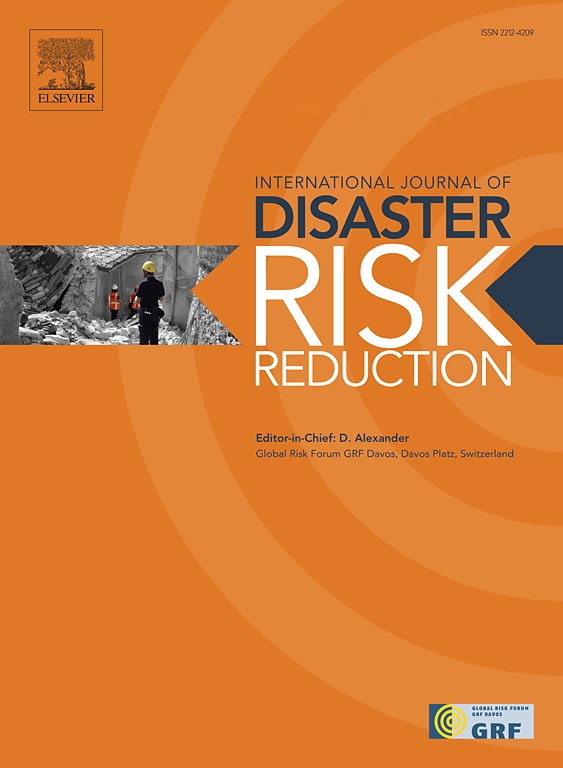Low-GWP flammable refrigerants and fire risk: The importance of leakage-induced vs reaction-influenced scenarios
IF 4.2
1区 地球科学
Q1 GEOSCIENCES, MULTIDISCIPLINARY
International journal of disaster risk reduction
Pub Date : 2025-04-10
DOI:10.1016/j.ijdrr.2025.105453
引用次数: 0
Abstract
HFCs became the predominant refrigerant type after the Montreal Protocol ban on CFCs and HCFCs due to ozone depletion characteristics. Whilst HFCs do not affect the ozone layer, they have significant global warming potential. Thus, the Kigali Amendment established a global phase-down of high-GWP HFCs. Low-GWP alternatives for applications in residential environments include hydrocarbons, HCs, such as R290, propane. The HCs present, however, higher flammability characteristics. Hence, international standards limit their allowable charge in residential applications. In 2022 these standards eased certain limits focusing on leakage control within closed spaces. Leakage of flammable refrigerants has been considered the primary fire hazard in research and regulations on this topic. Conversely, the reaction of components filled with refrigerants to an independent fire has not received the same attention, despite their key role in the energy transition. This study reviews the current research on the fire risk of flammable refrigerants and the relevant regulatory approach. The review and the analysis of relevant empirical evidence from past accidents highlight the importance of fire reaction compared to leakage hazards. The yearly probability of a leaked refrigerant ignition is seven orders of magnitude less likely than an independent fire. The heat release rate from components engulfed in fire is not negligible and refrigerants can increase it. Data show that external refrigerant units may support fires on building façades and involve combustible thermal insulation. Finally, novel event trees for quantitative fire risk assessment and possible mitigation measures are provided.

在《蒙特利尔议定书》禁止使用氯氟化碳和氟氯烃之后,氢氟碳化物因其臭氧消耗特性而成为最主要的制冷剂类型。虽然氢氟碳化物不会影响臭氧层,但它们具有显著的全球升温潜能值。因此,《基加利修正案》规定在全球范围内逐步减少全球升温潜能值较高的氢氟碳化物。住宅环境中应用的低全球升温潜能值替代品包括碳氢化合物,如 R290 和丙烷。不过,碳氢化合物具有较高的易燃性。因此,国际标准限制了它们在住宅应用中的允许充注量。2022 年,这些标准放宽了某些限制,重点是封闭空间内的泄漏控制。在相关研究和法规中,易燃制冷剂的泄漏一直被认为是主要的火灾隐患。相反,尽管制冷剂在能源转型中起着关键作用,但填充制冷剂的部件在独立火灾中的反应却没有得到同样的关注。本研究回顾了当前关于易燃制冷剂火灾风险的研究以及相关的监管方法。对以往事故的回顾和相关经验证据的分析突出了与泄漏危险相比,火灾反应的重要性。泄漏制冷剂起火的年概率比独立起火的概率低七个数量级。被火吞噬的部件的热释放率不容忽视,而制冷剂会增加热释放率。数据显示,外部制冷剂装置可能会支持建筑物外墙起火,并涉及可燃隔热材料。最后,提供了用于定量火灾风险评估的新型事件树和可能的缓解措施。
本文章由计算机程序翻译,如有差异,请以英文原文为准。
求助全文
约1分钟内获得全文
求助全文
来源期刊

International journal of disaster risk reduction
GEOSCIENCES, MULTIDISCIPLINARYMETEOROLOGY-METEOROLOGY & ATMOSPHERIC SCIENCES
CiteScore
8.70
自引率
18.00%
发文量
688
审稿时长
79 days
期刊介绍:
The International Journal of Disaster Risk Reduction (IJDRR) is the journal for researchers, policymakers and practitioners across diverse disciplines: earth sciences and their implications; environmental sciences; engineering; urban studies; geography; and the social sciences. IJDRR publishes fundamental and applied research, critical reviews, policy papers and case studies with a particular focus on multi-disciplinary research that aims to reduce the impact of natural, technological, social and intentional disasters. IJDRR stimulates exchange of ideas and knowledge transfer on disaster research, mitigation, adaptation, prevention and risk reduction at all geographical scales: local, national and international.
Key topics:-
-multifaceted disaster and cascading disasters
-the development of disaster risk reduction strategies and techniques
-discussion and development of effective warning and educational systems for risk management at all levels
-disasters associated with climate change
-vulnerability analysis and vulnerability trends
-emerging risks
-resilience against disasters.
The journal particularly encourages papers that approach risk from a multi-disciplinary perspective.
 求助内容:
求助内容: 应助结果提醒方式:
应助结果提醒方式:


